Menus
- Under high voltage
- 0 to 100 km / h in 4 seconds
- The story is speeding up
- Homogeneous integration
- A great toy !
- Riding modes: Range Ride and Power Ride
- A convincing prototype
Under high voltage
0 to 100 km / h in 4 seconds
Harley-Davidson invited us to the Michelin circuit in Ladoux to test its “Project Livewire” electric motorcycle prototype. A surprising machine that literally breaks with the codes of the brand and its legendary V-Twin engine ….
Although the advent of electric motorcycles still seems a long way off, for lack of a truly innovative battery technology that would offer a very long range and / or a super fast recharging capacity, really paving the way for this type of vehicle, most manufacturers cars and motorcycles are working hard to develop their own electric solution. Tesla being undoubtedly the most advanced, particularly with its installation of supercharger, including in France, which will make it possible to make a Paris-Marseille almost in one go, except for the break for a short recharging rest..
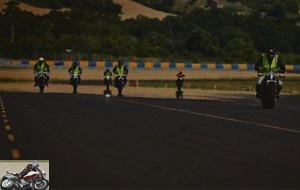 Harley-Davidson LiveWire Track Test
Harley-Davidson LiveWire Track Test
The American firm Harley-Davidson, however sometimes judged as conservative with its cult of the air-cooled V-Twin engine, surprises its world when it unveils in June 2014 its prototype electric motorcycle "Project LiveWire". A name which inevitably makes one think of the song Live Wire of the rock group AC / DC or, for the comic fans, of the super heroes of DC Comics…. It’s certainly no coincidence that this electric Harley-Davidson prototype appears in theaters in Marvel’s latest Avengers “Age of Ultron,” ridden by the charming Scarlett Johansson (aka Natasha Romanoff in the movie).
 Harley-Davidson LiveWire on the track
Harley-Davidson LiveWire on the track
For Harley-Davidson, the goal of Project LiveWire is twofold, with on the one hand the desire to change and modernize its brand image, on the other hand the need to survey the market in order to better meet the expectations of the next generations of consumers. , younger and not really attached to traditional values.
After the modernization of its range via Project Rushmore (consultation with customers resulting in more comfort and ease of use, better braking, increased safety, etc.), followed by the launch of the Street 500 and 750 models intended for less fortunate people, Harley-Davidson has therefore set up the Project LiveWire Experience operation. This consists of a major traveling tour through the USA during 2014, then in Europe in 2015, ending in Canada and again in the United States towards the end of the same year. At each stage, several groups of users (customers, journalists, neophytes….) Can try out the Project LiveWire prototype or discover it in static mode thanks to the “Jump Start” driving simulator, which allows people who do not have a license moto to discover and give their feedback on Project LiveWire. In the end, the brand is counting on the lessons of this operation to guide its future development and make itself better known to the younger generations..
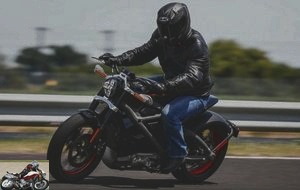 Harley-Davidson LiveWire on the road
Harley-Davidson LiveWire on the road
The story is speeding up
By detailing the Project LiveWire, we say to ourselves that we are lucky to participate in this adventure and to be somewhere on the cusp of a real technological change set to revolutionize our modes of transport and our perception of motorbike. Admittedly, there are many precedents, both in cars and in terms of motorcycles and scooters (Zero Motorcycles, KTM Freeride, BMW C-Evolution, etc.), but with an emblematic manufacturer of the caliber of Harley-Davidson we have really feel like history is finally speeding up.
Matt Levatich, President and COO (Chief Operating Officer) of Harley-Davidson ensures that the brand will market its first electric motorcycle before 2020 and that it will have at least 100 miles of autonomy (approximately 160 km). A close deadline and a relatively credible objective given the rapid evolution of battery technologies, ever more efficient, lighter and more compact. However, it will have to reckon with other major players if it wants to be the first big motorcycle manufacturer to invest in this market because the Polaris Industries group (Victory, Indian, etc.), which has just bought the brand of electric motorcycles Brammo and to enter two advanced prototypes in the Tourist Trophy, intends to toast him politeness ….
Other manufacturers are also investing in this new market, with smaller but equally enterprising players such as Energica, Tacita, Bultaco, Matra, Mugen…. while others, the world’s major two-wheeler market players, are lying in wait and laying out their weapons. We think in particular of Honda, Yamaha, Kawasaki, Suzuki and others. The ambitious Voxan-Venturi Wattman project has been abandoned as Venturi owner Gildo Pallanca Pastor recently decided to abandon production of electric vehicles..
So here we are on the Michelin circuit of Ladoux, a highly secure place because it is used by many partner constructors of the manufacturer to test their new products, welcomed by Gerald Staedelin, Managing Director of Harley-Davidson France and Xavier Crepet, Marketing and Communication Director.
Homogeneous integration
Beautifully designed, the LiveWire is naturally inspired by the aesthetic codes of the American brand, adopting a look vaguely reminiscent of a Sportster whose saddle has been repositioned, but also a Buell, formerly under the bosom of Harley-Davidson. The line is superb, with a very nice aluminum frame (6.35 kg) rallying a beautiful swingarm, a well-proportioned false fuel tank, beautiful 18 (front) and 17 (rear) inch wheels with alloy rims. Y-sticks fitted with Michelin Scorcher “11 F” tires (120 / 70×18 front and 180 / 55×17 rear) with Harley-Davidson logo.
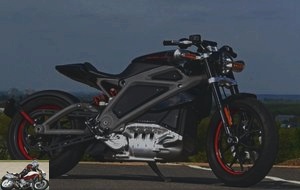 Harley-Davidson LiveWire Profile
Harley-Davidson LiveWire Profile
The suspension is entrusted to a fully adjustable Showa inverted fork and a horizontal mono-shock of the same brand with a separate cylinder, directly anchored to the swingarm..
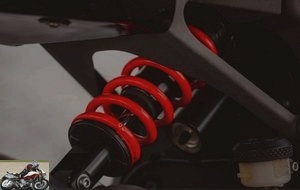 Harley-Davidson LiveWire Shock Absorber
Harley-Davidson LiveWire Shock Absorber
Braking is provided by Brembo brake elements, with a large front disc with 2-piston caliper and a small single-piston rear disc. From the front, we can appreciate a small round LED headlight framed by mirrors housed in a low position, under the handlebars and each incorporating a bar of LED indicators..
 Harley-Davidson LiveWire turn signals
Harley-Davidson LiveWire turn signals
The integration of the battery pack instead of the traditional V-Twin engine is perfectly achieved, a superb aluminum casing with sculpted and evocative shapes housing the electric motor housed in the low position. The brand has chosen to use a three-phase AC induction electric motor, powered by a 300 V lithium-ion battery, unlike other manufacturers who use 100/120 volt batteries. This engine, cooled by oil via an additional radiator, provides a power of 74 horsepower at 8,500 rpm, with a maximum torque of 70 Nm at 8,000 rpm, which is not negligible for a machine whose total weight in running order does not exceed 210 kg. According to a Harley technician, this electric motor could run at 15,000 rpm.
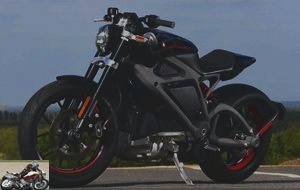 Harley-Davidson LiveWire left side
Harley-Davidson LiveWire left side
The final transmission is obviously entrusted to a toothed belt. For the moment, the battery charger is not integrated into the prototype, which requires the use of an external charger. A socket provided for this purpose is housed on the left side. According to the manufacturer, the power battery is charged in 3 hours 30 minutes with a 15 Ah charger. A second battery is used to power the lighting and the on-board electronics.
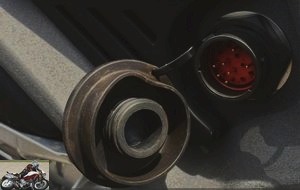 Harley-Davidson LiveWire power outlet
Harley-Davidson LiveWire power outlet
A great toy !
By taking control of Project LiveWire, we are surprised by its relative compactness. The seat is low and allows most riders to put both feet on the ground when stopped. The single-seater seat is quite comfortable and the knees naturally hug the bike, like most roadsters on the market. On the handlebars, there is no clutch lever of course, but a classic front brake lever on the right side and stems allowing interaction with the machine.
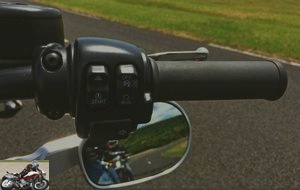 Harley-Davidson LiveWire Commodos
Harley-Davidson LiveWire Commodos
The on-board instrumentation takes place in the center of the flat bar handlebar, in the form of a beautiful digital touch screen with GPS function. This displays the status of the electrical system, including the battery charge level, its voltage, its operating temperature, the temperature of the liquid cooling system of the ECU, the remaining range according to the chosen driving mode and the charge time remaining when plugged in. It also displays the daily and partial odometer, as well as the percentage of power used. By acting on the touch screen areas, you can enter the configuration menu, change the type of value displayed and select the desired driving mode.
Riding modes: Range Ride and Power Ride
There is a choice between the “Range Ride” mode, which currently offers up to 85 km of range, and the “Power Ride” mode, which allows brighter acceleration but reduces the range to almost 65 km. In this mode, the LiveWire performs a standing start from 0 to 100 km / h in less than 4 seconds.
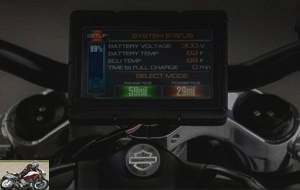 Harley-Davidson LiveWire Dashboard
Harley-Davidson LiveWire Dashboard
To start, you must first switch the circuit breaker to "on", choose your driving mode on the digital screen, then briefly press the "start" button. The display which until then indicated "111", in reference to the 111 years of existence of the brand, then changes to "O" to indicate that the motorcycle is powered up and ready to respond to the slightest rotation of the accelerator..
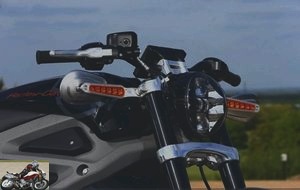 Harley-Davidson LiveWire headlight
Harley-Davidson LiveWire headlight
The acceleration response is extremely smooth and easy to dose with the grip. From the first turns of the wheels, the LiveWire reveals a great homogeneity of chassis, excellent maneuverability and good weight distribution. Very stable in line, it fits naturally on the angle, without excessive liveliness or the need to help it by counter-stepping on the handlebars. The driving position tilted slightly to the front, due to the rear footrests, allows a good feeling of the front axle and contributes to the driving pleasure of the machine, reinforcing the feeling of piloting a "power cruiser". A clear twist of the handle is enough to be convinced of this. Maximum torque is delivered instantly, with a progressive and linear power delivery that propels the LiveWire very quickly to its maximum speed of 153 km / h where the system is voluntarily regulated in order to preserve the autonomy of the battery.
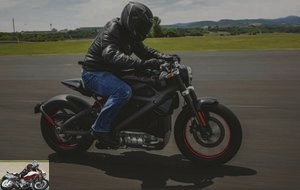 Harley-Davidson LiveWire on highway
Harley-Davidson LiveWire on highway
In "Power Ride" mode, the acceleration is further increased and the revs at mid-speed are much more lively…. a real toy! It’s hard to reason with yourself and not to “open wide” as soon as a stretch appears. The feeling of freedom usually felt on a motorcycle is here exacerbated by the absence of the usual exhaust and engine noise, the whistling of the electric motor like a jet airplane turbine echoing the movement of air to give the pilot the impression of fly over the asphalt of the runway. What a foot !
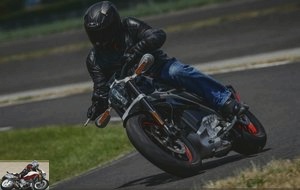 Harley-Davidson LiveWire on departmental
Harley-Davidson LiveWire on departmental
Apart from the footrest nipples which rub quickly as soon as you start to take a bit of an angle, the LiveWire feels good and enjoys a good job with the suspensions. When braking gently to enter a curve, all you have to do is surrender your hand to let yourself be slowed down by the natural “engine braking”, which also helps to recharge the battery. On the other hand, to stop more frankly, do not hesitate to grip the lever openly because the power of the front brake is not optimal. Especially since you can feel the mass transfer to the front when braking, with a rear wheel that tends to dribble as it is itself braked by the engine. The brake pedal brings a little extra power, without however mitigating this drible.
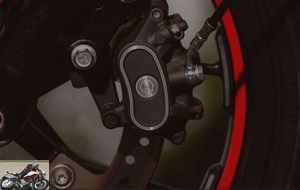 Harley-Davidson LiveWire Brakes
Harley-Davidson LiveWire Brakes
In the future, the brand will certainly add a little electronics to mitigate this phenomenon, as well as possible slippage of the rear wheel when accelerating in the wet via an anti-slip system. Ideally, you would even need a throttle grip acting directly on the power of the engine brake when turned in the opposite direction.
A convincing prototype
At the end of this test, we have to admit that Harley-Davidson’s proposal for an electric motorcycle is not without interest. Project LiveWire is already very promising and we look forward to seeing it evolve with technological advances in the field of batteries, because this is where the real challenge really lies. Once the ideal technology has been invented by an innovative startup, there is no doubt that the famous American firm will know how to take advantage of it, just like the main players in the market. For the moment, the forty prototypes of LiveWire continue to crisscross the roads of old Europe before returning to the American continent, for a last standstill? But we are already announcing a price envisaged around 20,000 euros … to be checked when the first production models come out, rather in 2018 or even 2019
Strong points
- engine power
Weak points
- dribbling under braking
Related articles
-
Harley-Davidson LiveWire electric motorcycle test
0 – 100 km / h in 3 seconds … Revolution… Revelation electric motor, 105 hp and 116.6 Nm, 249 kg, adjustable Showa suspensions, 150 km of range, from…
-
Test: Harley-Davidson Street 750
749 cm3, approx. 57 horses at 7,500 rpm, 59 N.m at 4,000 rpm, 206 kilos dry, from € 6,950 The most accessible way to enter the Harley-Davidson universe…
-
Harley-Davidson Road Glide CVO 117 test
Welcome to excess Harley-Davidson V2, 1923 cm3, 105 hp at 5450 rpm, 166 Nm at 3500 rpm, 385 kilos dry, from € 41,290 From when, too much is enough? What…
-
Harley-Davidson Street Bob 107 test
V2, 1745 cm3, 86 hp at 5020 rpm, 145 Nm at 3000 rpm, 297 kilos, from € 14,860 A change in philosophy from the Dyna family to the Softail family It’s been…
-
Harley-Davidson Fat Bob 114 test
V2, 1868 cm3, 94 hp at 5020 rpm, 155 Nm at 3000 rpm, 306 kilos, from € 19,660 Change of style and philosophy for this machine that migrates from the Dyna…
-
Harley-Davidson Freewheeler Test
V2, 1750 cm3, approx. 90 hp, 152 Nm at 3250 rpm, 492 kilos dry, from € 29,850 A stylish and stripped-down three-wheeler to discover the Harley-Davidson…
-
Harley-Davidson Breakout 114 test
V2, 1,868 cm3, 94 hp at 5,020 rpm, 155 Nm at 3,000 rpm, 305 kilos, from € 21,760 Harley’s bestseller has all the cards in hand to pursue a flamboyant…
-
Harley-Davidson CVO Street Glide 114 test
V2, 1868 cm3, around 100 hp, 165 Nm, 398 kilos with full fuel, € 39,550 A certain vision of the exception made in Milwaukee and a really punchy 114…
-
Double disc brake and inverted fork: a more dynamic version of the Sportster 1200 4 “Dark Custom” colors, from € 12,590 Globally, Harley-Davison remains…
-
Harley-Davidson Dyna Fat Bob FXDF Test Drive
A very frequentable Bad Boy ! Appearances can be deceiving. The Dyna Fat Bob, in its “man’s” machine air, stands out as one of the most versatile models…
Hello,
If the engine brake is so important, it is precisely because the designers have put an energy recovery system in it, allowing the autonomy of the machine to be increased, when a consumer is transformed into a generator, the torque effect is generated. makes you feel.
.


Why a traction control system ?
In any case not a classic system as we know it.
An electric motor delivers its maximum torque from 1 rpm anyway, to prevent slippage it suffices to regulate electrically by operating micro-cuts.
.
Performance question…
0-100 in 4 seconds…
Well it’s not terrible actually, a lot of 600 do it and a machine powered by an electric motor is capable of better..
Ah damn I forgot…
The laws of human physics do not depend on motive energy
Well this will limit the suns and it is also a limit certainly desired by the designers.
It promises good big delusions.
.
Technology question:
We can see that the Tesla firm in California is not far away.
.
Good day